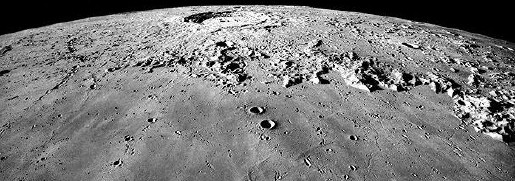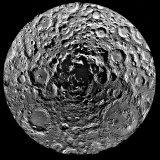 |
|||
|
Apollo 17 view across Mare Imbrium towards Copernicus.
|
|||
| THE IMPACT BASINS OF THE MOON | |||
| Impact basins are larger craters made by meteorites. Those which are encircled by one or more concentric mountain ranges are referred to as multi-ringed impact basins. Most of these were created during the great bombardment period, early on in the history of the Solar System. These are common on the Moon but have been found on other Solar System bodies including Mercury (Caloris) and Callisto (Valhalla). | |||
| Those easiest to see on the Moon have filled with dark lava forming mare. Not all have been flooded though. Some preserve the landforms that were set up by the impact. Aitken at the south pole is the largest basin on the Moon, but it is very difficult to distinguish. The most pristine, as well as being very circular, is Orientale. It has four well defined rings. The outer ring Montes Cordillera is 930 kilometres across. Moving inwards, Montes Rook measures 620 kilometres across, Inner Rook ring 480 kilometres, and the innermost ring 320 kilometres across. | |||
 Mosaic of Clementine images showing Aitken basin, the largest basin on the Moon. |
|||
| The very centre of the basin appears quite smooth as it is filled with lava, probably from the lunar interior. The rings are rugged, and there are knobbly hills and swells caused by melting of the rock. The low lying areas between the rings, in patches, are filled with smooth dark lavas. | |||
 Orientale, 930 kilometres across, imaged by the Galileo spacecraft. |
|||
| Understanding how such basins form is not easy. There are several alternatives but the most satisfactory explanation of how multiple rims are formed is by oscillation of the surface. The shock wave of the impact starts a series of rebound and uplift events, making the surface move up and down. For a short time the surface behaves like a liquid. The waves, or rings in this case, eventually freeze in place. | |||
|
|
|||